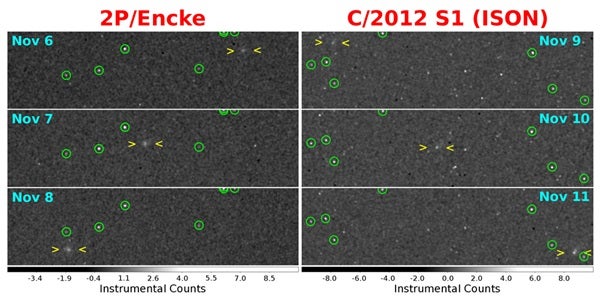This figure shows, on the left, images of Encke on three successive days from November 6 to November 8; on the right, images of ISON are shown for three successive days from November 9 to November 11. Both comets appear to brighten each day (top to bottom).
Green circles indicate some of the brighter cataloged background stars in each image; yellow marks bracket the comets. The background stars are fixed in each image from top to bottom, so the motion of the comet relative to the stars is clear in each case. The images have been smoothed slightly to diminish the distracting sharp edges of the pixels.
ISON was discovered in September 2012 by amateur Russian astronomers, who observed with a 16-inch telescope that is part of the International Scientific Optical Network (ISON), discovered after which the comet was named.
On November 28, ISON will fly within 700,000 miles (1.2 million kilometers) of the Sun’s photosphere, at which time it is expected either to flare brilliantly or disintegrate.
As part of an ISON observation campaign involving ground- and space-based NASA observatories, as well as many other observatories around the world, MESSENGER has been poised for several weeks to collect observations of ISON. From November 9 through November 11, the probe’s Mercury Dual Instrument System (MDIS) captured its first images of the comet.
“We are thrilled to see that we’ve detected ISON,” said Ron Vervack from the Johns Hopkins University Applied Physics Laboratory in Baltimore, Maryland. “The comet hasn’t brightened as quickly as originally predicted, so we wondered how well we would do. Seeing it this early bodes well for our later observations.”
A few days earlier, from November 6 through November 8, MESSENGER’s imagers picked up its first snapshots of Encke. Unlike ISON, Encke has been known for quite a while. It was discovered in 1786 and recognized as a periodic comet in 1819. Its orbital period is 3.3 years — the shortest period of any known comet — and November 21 will mark its 62nd recorded perihelion.
“Encke has been on our radar for a long time because we’ve realized that it would be crossing MESSENGER’s path in mid-November of this year,” Vervack said. “And not only crossing it, but coming very close to Mercury.” These early images of both comets are little more than a few pixels across, Vervack said, but he expects improved images next week when the comets make their closest approaches to MESSENGER and Mercury.
On November 18, just a few days shy of its perihelion on November 21, Encke will travel within 2.3 million miles (3.7 million km) of Mercury. According to the Minor Planet Center, if Encke came this close to Earth, it would rank as the third closest known approach of a comet to our planet. On November 19, ISON will pass within 22.5 million miles (36.2 million km) of Mercury while at a distance of 44 million (71 million km) from the Sun.
“By next week, we expect Encke to brighten by approximately a factor of 200 as seen from Mercury, and ISON by a factor of 15 or more,” Vervack said. “So we have high hopes for better images and data.” Three of MESSENGER’s instruments — MDIS, the Mercury Atmospheric and Surface Composition Spectrometer, and the X-Ray Spectrometer — will be trained on the two comets and will collect as many observations as payload operational constraints will allow.
There are complicating issues that could impact the volume of data the team gathers, Vervack said. “Closest approach occurs during what we call a ‘hot season,’” he said. “So, for the health of the spacecraft, portions of each orbit must be spent in a thermally safe mode, which precludes gathering data over the entire orbit.”
The critical observations also happen during a low-downlink period for MESSENGER. “We can’t fill up the spacecraft recorder with comet data because doing so could cause a backlog that impacts our primary mission of collecting observations from Mercury,” Vervack said. But the team is optimistic that all will go as planned. “We just need the comets to hold up their end of the bargain.”










